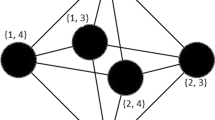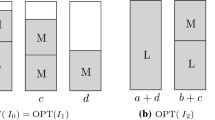Abstract
This paper examines the constructive Hausdorff and packing dimensions of Turing degrees. The main result is that every infinite sequence S with constructive Hausdorff dimension dim H(S) and constructive packing dimension dim P(S) is Turing equivalent to a sequence R with dim H(R)≥(dim H(S)/dim P(S))−ε, for arbitrary ε>0. Furthermore, if dim P(S)>0, then dim P(R)≥1−ε. The reduction thus serves as a randomness extractor that increases the algorithmic randomness of S, as measured by constructive dimension.
A number of applications of this result shed new light on the constructive dimensions of Turing degrees. A lower bound of dim H(S)/dim P(S) is shown to hold for the Turing degree of any sequence S. A new proof is given of a previously-known zero-one law for the constructive packing dimension of Turing degrees. It is also shown that, for any regular sequence S (that is, dim H(S)=dim P(S)) such that dim H(S)>0, the Turing degree of S has constructive Hausdorff and packing dimension equal to 1.
Finally, it is shown that no single Turing reduction can be a universal constructive Hausdorff dimension extractor, and that bounded Turing reductions cannot extract constructive Hausdorff dimension. We also exhibit sequences on which weak truth-table and bounded Turing reductions differ in their ability to extract dimension.
Similar content being viewed by others
References
Athreya, K., Hitchcock, J., Lutz, J.H., Mayordomo, E.: Effective strong dimension, algorithmic information and computational complexity. SIAM J. Comput. 37, 671–705 (2007)
Bienvenu, L., Doty, D., Stephan, F.: Constructive dimension and weak truth-table degrees. In: Cooper, S.B., Löwe, B., Sorbi, A. (eds.) Computation and Logic in the Real World—Third Conference of Computability in Europe (CiE 2007), Siena, Italy, June 18–23, 2007, Proceedings. Lecture Notes in Computer Science, vol. 4497, pp. 63–72. Springer, Berlin (2007)
Calude, C.S., Chaitin, G.J.: Randomness everywhere. Nature 400, 319–320 (1999)
Doty, D.: Every sequence is decompressible from a random one. In: Logical Approaches to Computational Barriers, Proceedings of the Second Conference on Computability in Europe, Swansea, UK, July 2006. Lecture Notes in Computer Science, vol. 3988, pp. 153–162. Springer, Berlin (2006)
Doty, D.: Dimension extractors and optimal decompression. Theory Comput. Syst. 43(3), 425–463 (2008). Special issue of invited papers from Computability in Europe 2006
Fortnow, L., Hitchcock, J.M., Aduri, P., Vinodchandran, N.V., Wang, F.: Extracting Kolmogorov complexity with applications to dimension zero-one laws. In: Proceedings of the 33rd International Colloquium on Automata, Languages and Programming. Lecture Notes in Computer Science, vol. 4051, pp. 335–345. Springer, Berlin (2006)
Friedberg, R., Rogers, H.: Reducibilities and completeness for sets of integers. Z. Math. Log. Grundl. Math. 5, 117–125 (1959)
Hausdorff, F.: Dimension und äusseres Mass. Math. Ann. 79, 157–179 (1919)
Hemaspaandra, L., Hempel, H., Vogel, J.: Optimal separations for parallel versus sequential self-checking: parallelism can exponentially increase self-checking cost. Technical Report TR 691, Department of Computer Science, University of Rochester, May 1998
Li, M., Vitányi, P.M.B.: An Introduction to Kolmogorov Complexity and its Applications, 2nd edn. Springer, Berlin (1997)
Lutz, J.H.: Dimension in complexity classes. SIAM J. Comput. 32, 1236–1259 (2003)
Lutz, J.H.: The dimensions of individual strings and sequences. Inf. Comput. 187, 49–79 (2003)
Lutz, J.H.: Effective fractal dimensions. Math. Log. Q. 51, 62–72 (2005). (Invited lecture at the International Conference on Computability and Complexity in Analysis, Cincinnati, OH, August 28–30, 2003)
Mayordomo, E.: A Kolmogorov complexity characterization of constructive Hausdorff dimension. Inf. Process. Lett. 84(1), 1–3 (2002)
Miller, J.: Extracting information is hard. Technical Report (2008). http://www.math.uconn.edu/~josephmiller/Papers/dimension.pdf
Nies, A., Reimann, J.: A lower cone in the wtt degrees of non-integral effective dimension. In: Proceedings of IMS workshop on Computational Prospects of Infinity, Singapore (2009, to appear). Earlier version appeared as Technical Report 63, Workgroup Mathematical Logic and Theoretical Computer Science, University of Heidelberg (2005)
Odifreddi, P.: Classical Recursion Theory. Studies in Logic and the Foundations of Mathematics, vol. 125. North-Holland, Amsterdam (1989)
Post, E.L.: Recursively enumerable sets of positive integers and their decision problems. Bull. Am. Math. Soc. 50, 284–316 (1944)
Reimann, J.: Computability and fractal dimension. Doctoral thesis, Heidelberg (2005)
Reimann, J., Slaman, T.: Randomness, Entropy and Reducibility. Manuscript (2005)
Ryabko, B.Ya.: Coding of combinatorial sources and Hausdorff dimension. Sov. Math. Dokl. 30, 219–222 (1984)
Ryabko, B.Ya.: Noiseless coding of combinatorial sources. Probl. Inf. Transm. 22, 170–179 (1986)
Shaltiel, R.: Recent developments in explicit constructions of extractors. Bull. EATCS 77, 67–95 (2002)
Soare, R.I.: Recursively Enumerable Sets and Degrees. Springer, Berlin (1987)
Stephan, F.: Hausdorff-dimension and weak truth-table reducibility. Technical Report TR52/05, School of Computing, National University of Singapore (2005)
Sullivan, D.: Entropy, Hausdorff measures old and new, and limit sets of geometrically finite Kleinian groups. Acta Math. 153, 259–277 (1984)
Tricot, C.: Two definitions of fractional dimension. Math. Proc. Camb. Philos. Soc. 91, 57–74 (1982)
Turing, A.M.: Systems of logic based on ordinals. Proc. Lond. Math. Soc. 45, 161–228 (1939)
Zimand, M.: Two sources are better than one for increasing the Kolmogorov complexity of infinite sequences. Technical Report 0705.4658, Computing Research Repository (2007)
Author information
Authors and Affiliations
Corresponding author
Additional information
F. Stephan was supported in part by NUS research grants Nos. R252-000-212-112 and R252-000-308-112.
Rights and permissions
About this article
Cite this article
Bienvenu, L., Doty, D. & Stephan, F. Constructive Dimension and Turing Degrees. Theory Comput Syst 45, 740–755 (2009). https://doi.org/10.1007/s00224-009-9170-1
Received:
Accepted:
Published:
Issue Date:
DOI: https://doi.org/10.1007/s00224-009-9170-1




